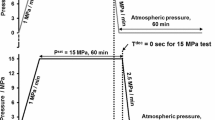Abstract
The relationship between internal fracture due to high-pressure hydrogen decompression and microstructure of ethylene–propylene–diene–methylene linkage (EPDM) rubber was investigated by atomic force microscopy (AFM). Nanoscale line-like structures were observed in an unexposed specimen, and their number and length increased with hydrogen exposure. This result implies that the structure of the unfilled EPDM rubber is inhomogeneous at a nanoscale level, and nanoscale fracture caused by the bubbles that are formed from dissolved hydrogen molecules after decompression occurs even though no cracks are observed by optical microscopy. Since this nanoscale fracture occurred at a threshold tearing energy lower than that obtained from static crack growth tests of macroscopic cracks (T s,th), it is supposed that nanoscale structures that fractured at a lower threshold tearing energy (T nano,th) than T s,th existed in the rubber matrix, and these low-strength structures were the origin of the nanoscale fracture. From these results, it is inferred that the fracture of the EPDM rubber by high-pressure hydrogen decompression consists of two fracture processes that differ in terms of size scale, i.e., bubble formation at a submicrometer level and crack initiation at a micrometer level. The hydrogen pressures at bubble formation and crack initiation were also estimated by assuming two threshold tearing energies, T nano,th for the bubble formation and T s,th for the crack initiation, in terms of fracture mechanics. As a result, the experimental hydrogen pressures were successfully estimated.









Similar content being viewed by others
References
Briscoe BJ, Savvas T, Kelly CT (1994) Rubber Chem Technol 67:384
Gent AN, Tompkins DA (1969) J Appl Phys 40:2520
Gent AN, Lindley PB (1958) Proc R Soc Lond A 249:195
Lindsey CH (1967) J Appl Phys 38:4843
Stevenson A, Glyn M (1995) Rubber Chem Technol 68:197
Stewart CW (1970) J Polym Sci A 8:937
Zakaria S, Briscoe BJ (1990) Chemtech 20:492
Ender DH (1986) Chemtech 16:52
Briscoe BJ, Liatsis D (1992) Rubber Chem Technol 65:350
Epstein PS, Plesset MS (1950) J Chem Phys 18:1505
Yamabe J, Nishimura S (2009) Trans J Soc Mech Eng A 75:633
Yamabe J, Nishimura S (2009) Trans J Soc Mech Eng A 75:1726
Yamabe J, Nishimura S (2010) In: 18th European conference on fracture, CD-ROM
Yamabe J, Nishimura S (2009) In: Proceedings of the 14th symposium on fracture and fracture mechanics, pp 30–34
Yamabe J, Nishimura S (2009) Int J Hydrogen Energy 34:1977
Yamabe J, Matsumoto T, Nishimura S (2010) J Soc Mater Sci Jpn 59:956
Thomas AG (1960) J Appl Polym Sci 8:168
Lake AJ, Lindley PB (1964) J Appl Polym Sci 8:707
Ikeda Y, Yasuda Y, Hijikata K, Tosaka M, Kohjiya S (2008) Macromolecules 41:5876
Dohi H, Sakai M, Nakamae H, Kimura H, Kotani M, Kishimoto H, Minagala Y (2007) Kautsch Gummi Kunstst 01–02:52
Acknowledgement
This research was supported by the NEDO Fundamental Research Project on Advanced Hydrogen Science (2006–2012).
Author information
Authors and Affiliations
Corresponding author
Rights and permissions
About this article
Cite this article
Yamabe, J., Nishimura, S. Nanoscale fracture analysis by atomic force microscopy of EPDM rubber due to high-pressure hydrogen decompression. J Mater Sci 46, 2300–2307 (2011). https://doi.org/10.1007/s10853-010-5073-4
Received:
Accepted:
Published:
Issue Date:
DOI: https://doi.org/10.1007/s10853-010-5073-4




